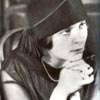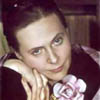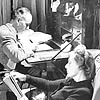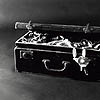- sale
- new items
- lovely beads
- wedding beads
- beads for teens
- for custom order
- newsletter
- recognition
- testimonials
- birthstones
- zodiac signs
- jewelry guide
SHOP BAG
![]() in your bag 0 items
in your bag 0 items
|
You made jewels for the city and in the evening, Everything turned into necklaces in your opera hands, I went to sell them to merchants of New York and elsewhere, From Berlin, from Rio, from Milan, from Ankara, These jewels that you made with your gold fingers. |
| Louis Aragon |
Born Ella Kagan in Moscow, Russia, in 1929 the young writer Elsa Triolet, not assuming about her future glory as a famous French novelist, decided to design jewelry making money for living. This short period in her life is less well known than her youth friendly relations with the aspiring futurist poet and graphic artist Vladimir Mayakovsky who became the greatest poet of the Soviet epoch. In 1915 Elsa invited him home, and the poet fell madly in love with her older sister Lilya, who was married to Osip Brik. Later Elsa was the first to translate Mayakovsky's poetry (as well as volumes of other Russian-language poetry) into French.
The late 1920s are also much less known than the time when Elsa's talent as a writer was crowned by the Prix Goncourt (in 1944), France's top literary award, for "A Fine of 200 Francs" (Le premier accroc coute 200 francs) (1), a book of short stories where she described her impressions about her participation in the French Resistance during World War II. Elsa Triolet is the first woman who won the Prix Goncourt!
Once Elsa Triolet had made a sufficient amount of jewels to sell, she was helped in business by her life companion and husband, the French poet and writer Louis Aragon, whom she had met at the renowned cafe La Coupole in Paris in 1928. Her creations stood out from other jewelry that has been made at that period by originality and a great diversity of materials and forms: coconuts, paper mache, metal, rhinestones, mother-of-pearl, porcelain, beads, bakelite, leather.
One of the first Elsa's jewelry pieces made out of found objects was sold to Elsa Schiaparelli, and further Elsa Triolet's jewels were intended for Parisian Haute Couture houses; she made jewelry for different couturiers with Louis Aragon acting as the salesman. Elsa spent the money earned from the sales of her jewelry to organize a trip to Russia in 1930 where the couple attended a congress of revolutionary writers in Kharkov (2). During their lives the couple had made several trips to the USSR.
Elsa Triolet and Louis Aragon made up a mythical couple being the activists of the French Communist Party as well as high personalities in the literary world until their death (Elsa: 1896-1970 and Louis: 1897-1982). It is also exceptional enough to stress that Elsa, initially called Ella or Allia and nicknamed Wild Strawberry (3) in her youth, had always written in Russian and French languages equally. Elsa kept her diary in French and started writing her novels directly in French in 1937.
Elsa Triolet's legacy to the library of Saint-Etienne-du-Rouvray, now called Elsa Triolet library
It is by the will of Aragon that the Elsa Triolet's necklaces can be found today in Saint-Etienne-du-Rouvray, in tribute to one of the first Elsa Triolet libraries in France. In 1949 Raymonde Lefevre, a young activist from that city met Elsa Triolet at the congress in Marseille about the Book Battle, a movement initiated by the French Communist Party to create libraries for working class people. With Elsa Triolet's support, Raymond Lefevre opened the first library in his city beginning with 142 books.
Elsa Triolet's jewels have been exhibited numerous times, first in 1972 in the National Library in Paris, then in Saint-Etienne-du-Rouvray several times: in 1987, 1996. The collection was lent to the Museum of Fashion in Paris on the occasion of an exhibition about Elsa Schiaparelli's fashion designs. But the necklaces are fragile and some are in need of restoration (4). In the meantime, they can be watched through a virtual online gallery.
References:
| (1) "A Fine of 200 Francs" (Le premier accroc coute 200 francs), a book of short stories where Elsa Triolet described her impressions about her participation in the French Resistance during World War II. The title in French is the coded sentence used by the Resistance fighters to announce the landing of Allied Forces in Southern France. |
| (2) From the book "Elsa-Aragon: the ambiguous couple" by Dominique Desanti (in French) |
| (3) "Wild Strawberries" (Fraise des bois - Zemlianika), the book by Elsa Triolet about her childhood memories written in Russian. |
| (4) The article on Elsa Triolet: Words and jewelry: unknown episode in the life of Elsa Triolet and Louis Aragon |
Jewelry by Elsa Triolet
(source:
www.ville-saintetiennedurouvray.fr)
About author:
| Blandine Guyot, La Villeneuve-au-Chatelot, Aube department, France | |
| Email address: | |
| Personal blog: | nushkabijoux.canalblog.com |
| Blog Perles et Dent'Elles: | perlesdentelles.canalblog.com |
| Facebook: | www.facebook.com |





